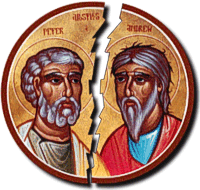It was last summer that I noticed something about my participation in courses and conferences for those abused by faulty religion. It was the fact that, unlike almost all my fellow attendees, I have never had to endure the experience of being abused and humiliated by religious leaders. That seemed to be the experience of everyone else, and it was particularly striking last summer in Washington DC. Participation in the conference almost seemed to require a story of pain, heartbreak and long slow recovery from an abusive situation in the past. Attendance at the conference was indeed, for many, part of this long process of returning to psychological health. Having pointed out this fact that, apart from facing parishioners who believed that they had all the answers to what they thought was wrong with my church, I am largely free of the pain that Chris and many others refer to in their experience of church. Any reader who wants to know more about why I choose to involve myself in this whole area, should consult the pages at the beginning of this blog. They may get some idea how I came to be in this place of wanting to help those who suffer pain because of religious abuse.
There is an argument for believing that I could be more effective in assisting others, who have gone through times of cultic or religious abuse, if I had suffered something similar. But there is also a strong case for saying that my freedom from this particular kind of emotional pain allows me to be clear eyed about the problem. As the followers of my posts will witness, I do understand a bit about the dynamics of religious groups which gives me some insights into these problems. Sufferers of religious or cultic abuse sometimes prefer to hear, not ‘I feel your pain’, but a more detached analysis of how person A. manipulated and plotted to take over a group in order to extract emotional and financial benefit for himself. (It is normally a him!) This objective comprehension of the dynamics of abuse will help some to rise up, even if only temporarily, above the emotional pain and take back a certain level of control. They now understand better why they feel in the way they do. It is my claim that new insight into a problem of a painful nature in your past will normally assist you to deal with it better. Sometimes it even helps to see the perpetrator of some evil against you as themselves a victim. What they did still hurts terribly years later but the insight that can be gained as to why they found it ‘necessary’ to damage others, will ease a little of the emotional pain felt now.
Blog followers will know that I am following closely the events taking place in Brentwood where an abusive church is being pressured to face up to its past. The former leader, Michael Reid, who was sacked (at massive expense) by the Trustees in 2008, continues to haunt the church, partly because no one wants to look back at the appalling history of his abuse. Ostensibly he was removed for an illicit sexual liaison with a church member but there is much more abuse hidden in the church’s history. My interest in the church is partly because I visited it during my research into abusive churches in the 1990s, but also the blog, that is run by one Nigel Davies, continues to throw up fascinating material both from current as well as former members. In my retirement, I cannot access case studies as rich as this for my interest in religious abuse, so this blog and its evolving story grips my attention. I find myself able from time to time able to offer comments and interpretation on-line. One thing that intrigues me, in particular, is that, to all appearances, Michael Reid seems to fulfil all the criteria for being a prototypical narcissistic charismatic leader. Lest this sound as though I am trying to level at Michael Reid an insult of maximum impact, let me say at once that this description from psychoanalytic language is as much about the damage probably done to him at an early age. In other words although the description of ‘narcissist’ sounds like an accusation, it is also a description of someone who may have had much evil visited on them first. Further the fact that a particular narcissist has been allowed to wreak horrendous damage on others, is a criticism of the culture that tolerates this kind of grandiose behaviour, as though it were acceptable. Churches, especially in the States, seem to love the larger-than life personalities that emerge within the charismatic evangelical world, but these places, where these personalities are allowed to lead and run amok, are ones best shut down. So to repeat, the prototypical narcissist like Michael Reid is often a victim of faulty rearing, so that, in adulthood, such an individual has a massive ‘deficit’ of self-esteem. He works hard to experience the self-esteem once denied to him as a child and consequently other people are ruthlessly manipulated to achieve an emotional ‘high’ which may fill a yawning emptiness within him. The literature suggests that, along the way, the narcissist has become less than empathetic to the needs of other people, because his need to be constantly affirmed is massive. Other people are ruthlessly exploited as the targets of his power games. The narcissist may dominate them or demand their slavish adoration, and these behaviours are both stock in trade for the narcissist. It is in noticing this dynamic that can offer an insight into the dysfunction and problems that pervade so many cult-like churches.
The pain of becoming subject to a malign narcissist can be terrible and life-long. The two aspects of the relationship that I have mentioned, demanding from people slavish adoration or subjecting them to abject humiliation, are both incredibly damaging. I realise from my word count that I need to bring this post to a close for now and leave further comments on the subject of the pain of victims for another time. But today I ask my reader to consider the damage that religious leaders can and do create in their followers. There is of course more to be said and I will return to the topic of the pain of abuse in another blog.

